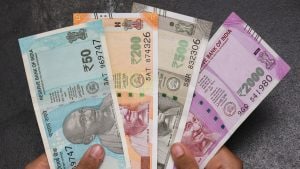India’s borrowing cost rises for 11th consecutive month, says Care Ratings
Summary
The cost of borrowing for the government rose for the 11th consecutive month at Rs 48,000 crore in July 2018, according to a monthly report by Care Ratings.
The cost of borrowing for the government rose for the 11th consecutive month at Rs 48,000 crore in July 2018, according to a monthly report by Care Ratings.
For a cumulative period from April to July 2018, the centre raised about Rs 183,981 crore by way of market borrowings, 26 percent less in the comparable period last year, said ‘Debt Market Review: July 2018’ report.
Here are the detailed highlights of the report:
Treasury Bill Auction:
In July, the aggregate treasury bills auctioned was at Rs 72,000 crore or 20 percent higher on a monthly basis. The weighted average yield for these auctions stood at 6.78 percent, up two percent from the previous month.

State Government Borrowings:
About 17 states raised Rs 32,926 crore by ways of state development loans (SDLs), which was 65 percent higher than the previous month. “The amount raised via SDLs in July 2018 was Rs 7,824 crore less than the notified amount as Andhra Pradesh, Maharashtra and Punjab accepted lower number of bids,” the rating agency added.
For the fiscal year 2019, the total amount of borrowings by all the state amounted to Rs 1.10 lakh crore, 12 percent higher than the borrowings of Rs 98,218 crore in the comparable period in FY18.
The weighted average yield of SDLs (all states) for July 2018 at 8.48 percent was 8 bps higher than that in the previous month.

Corporate Bond Issuances:
According to the report, the total corporate bond issued in the month of July stood at Rs 26,407 crore, 30 percent lower than the previous month.
Private placements accounted for 96 percent of the total issuances (Rs 25,407 crore) and public issues amounted to Rs 1,000 crore (four percent of total issuances), the report said, adding that there has been a decline in corporate bond issuances in the current fiscal during April-July 2018.
It totaled to Rs 1.12 lakh crore, down 48 percent during the comparable period a year ago. This decline can be largely attributed to the lower issuances by financial services, housing finance and banking/terms lending, the report said.

Commercial paper issuances:
Commercial paper issuances by corporates have risen in the current fiscal year as Rs 8.30 lakh crore were issued during the April to July 2018 period, up 41 percent more than the issuance of Rs 5.87 lakh crore in the comparable period last year.

Liquidity Conditions:
In July, the liquidity condition in the banking system went from net surplus of Rs 13,767 crore to net deficit of Rs 25,207.
“In July 2018, the daily average repo borrowings of the commercial banks to meet their short term liquidity requirements were at Rs 9,429 crore, 27 percent higher than the average daily repo borrowings in June 2018 (Rs 7,402 crore).
On the other hand, the average daily reverse repo borrowings fell by 41 percent to Rs 17,310 crore compared with the daily reverse repo borrowings worth Rs 29,346 crore in June 2018,” the report said.

Banking:
The aggregate bank deposits as of July 20 was at Rs 114.4 lakh crore and the outstanding bank credit stood at Rs 86.13 lakh crore.
The incremental bank deposit was up by 0.1 percent as against a negative 1.7 percent in the corresponding period last year. The incremental credit growth also narrowed to a negative of 0.1 percent from a negative of 2.3 percent.


Elon Musk forms several ‘X Holdings’ companies to fund potential Twitter buyout
3 Mins Read
Thursday’s filing dispelled some doubts, though Musk still has work to do. He and his advisers will spend the coming days vetting potential investors for the equity portion of his offer, according to people familiar with the matter









 Listen to the Article
Listen to the Article  Daily Newsletter
Daily Newsletter





